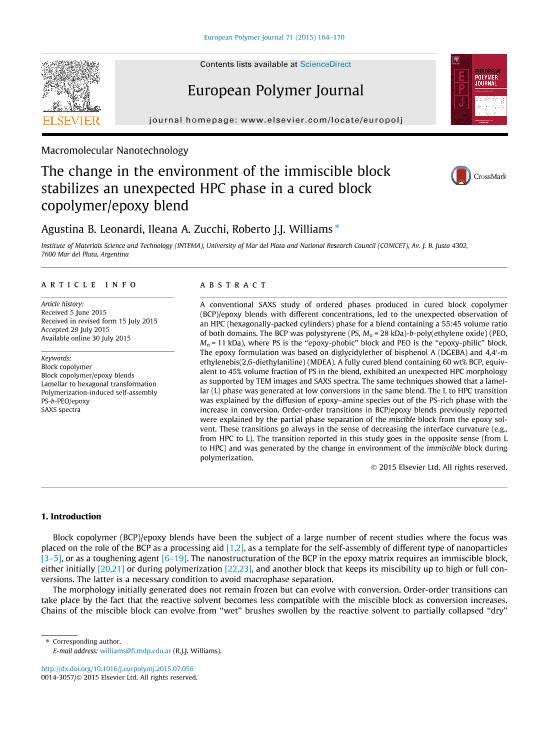Artículo
The change in the enviroment of the immscible block stabilizes an unexpected HPC phase in cured block copolymer/epoxy blend
Fecha de publicación:
30/07/2015
Editorial:
Elsevier
Revista:
European Polymer Journal
ISSN:
0014-3057
Idioma:
Inglés
Tipo de recurso:
Artículo publicado
Clasificación temática:
Resumen
A conventional SAXS study of ordered phases produced in cured block copolymer (BCP)/epoxy blends with different concentrations, led to the unexpected observation of an HPC (hexagonally-packed cylinders) phase for a blend containing a 55:45 volume ratio of both domains. The BCP was polystyrene (PS, Mn = 28 kDa)-b-poly(ethylene oxide) (PEO, Mn = 11 kDa), where PS is the “epoxy-phobic” block and PEO is the “epoxy-philic” block. The epoxy formulation was based on diglycidylether of bisphenol A (DGEBA) and 4,4′-methylenebis(2,6-diethylaniline) (MDEA). A fully cured blend containing 60 wt% BCP, equivalent to 45% volume fraction of PS in the blend, exhibited an unexpected HPC morphology as supported by TEM images and SAXS spectra. The same techniques showed that a lamellar (L) phase was generated at low conversions in the same blend. The L to HPC transition was explained by the diffusion of epoxy–amine species out of the PS-rich phase with the increase in conversion. Order-order transitions in BCP/epoxy blends previously reported were explained by the partial phase separation of the miscible block from the epoxy solvent. These transitions go always in the sense of decreasing the interface curvature (e.g., from HPC to L). The transition reported in this study goes in the opposite sense (from L to HPC) and was generated by the change in environment of the immiscible block during polymerization.
Archivos asociados
Licencia
Identificadores
Colecciones
Articulos(INTEMA)
Articulos de INST.DE INV.EN CIENCIA Y TECNOL.MATERIALES (I)
Articulos de INST.DE INV.EN CIENCIA Y TECNOL.MATERIALES (I)
Citación
Leonardi, Agustina Belen; Zucchi, Ileana Alicia; Williams, Roberto Juan Jose; The change in the enviroment of the immscible block stabilizes an unexpected HPC phase in cured block copolymer/epoxy blend; Elsevier; European Polymer Journal; 71; 30-7-2015; 164-170
Compartir
Altmétricas




